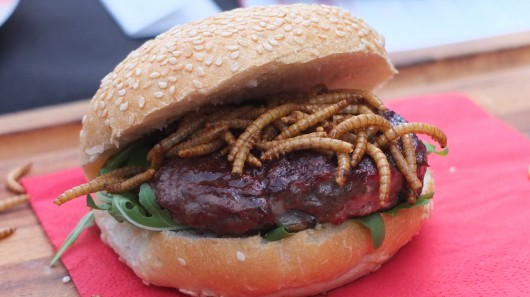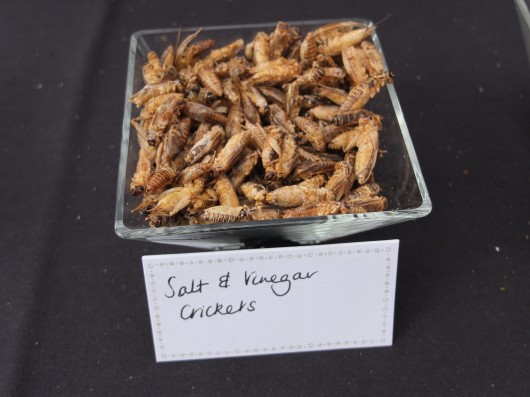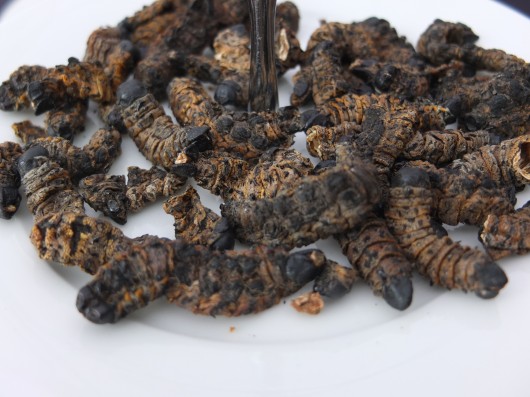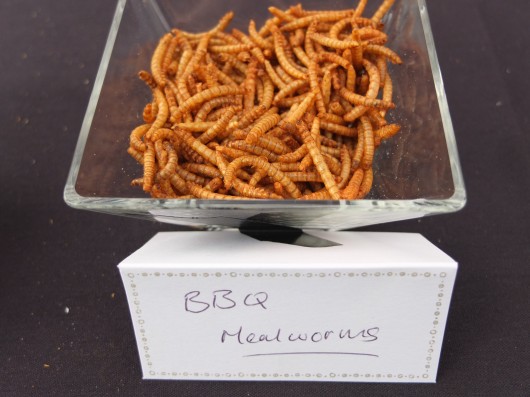Insects: The future of food? Gizmag goes "taste buds on" with grubs, crickets and caterpillars
August 16, 2013

You want flies with that? Mealworms on a pigeon burger at Rentokil's pop-up 'pestaurant' (Photo: Gizmag)
By 2050, the UN expects that there will be almost 10 billion people on the Earth. This poses some serious practical questions, not least among which is how we'll put food into 2.5 billion or so extra tummies (especially given that we don't adequately fill all of the 7-plus billion we already have). If you're yet to hear alarming phrases like "food security" and "sustainable intensification" you've probably been living under a rock. Which is apt, actually, because that's exactly where you might find one of the proposed answers: insects. A pop-up kitchen in London on Thursday served up a variety of bug-based bites to passers by, and Gizmag arrived soon after it opened to sample the wares on offer.
If the need for entomophagy – eating insects – sounds like alarmism, the idea is being taken seriously by the UN's Food and Agriculture Organization (FAO), which released a report on this very subject earlier this year.
Chief among the arguments is that insects are very efficient to rear compared to other sources of animal protein. Cattle requires 12 times more feedstock than do crickets per unit mass of protein grown, while requiring less land and water, and generating less greenhouse gas and ammonia.
Eating insects isn't the only option being explored, of course. But synthetic meat is in the very early stages of development, and good old vegetarianism suffers next to humanity's seemingly insatiable appetite for meat. China's expanding and beef-loving middle class has seen the country's meat consumption boom from 10 kg per person in the mid 1970s to 45 kg per person by 2010. (Australia's supply of red meat to China increased 214 percent between 2012 and 2013.)
It's only really in the economic West where the idea of eating insects is an alien concept. According to the FAO, 1,900 different insect species are consumed by 2 billion or so people in more than 80 countries across Asia, Africa and the Americas.
This was about 10:30 a.m. Apparently things got busier by lunchtime (Photo: Gizmag)
As of approximately 10.30 a.m. local time, there were at least a dozen or so more thanks to a pop-up kitchen (or "pestaurant") organized by Rentokil to celebrate 85 years in the pest control business. It was a neat enough publicity stunt, but besides the point. Out of curiosity more than desire, I'd been looking for an opportunity to sample insects for some time, so I was buying what Rentokil was selling … or giving away, as it happens.
Disappointingly, the menu available was both altered and reduced from the one which was circulated ahead of the event. Gone were roasted salted queen weaver ants, barbecue zebra tarantula (no, not an insect) and numerous other exotic-sounding items. A Rentokil PR person tells Gizmag that this was due to an import license that temporarily went missing. Still, there was no shortage of insects to sample, and Gizmag gamely tucked into crickets (Thai green curry and salt and vinegar flavor), barbecue mealworms and sun-dried emperor moth caterpillars followed by chocolate-dipped grasshoppers and ants.
Actually, the main course was a sweet chilli pigeon burger, the loose theme of the day being pests rather than insects, but I wasn't interested. Odds were against this being a grimy stub-footed London pigeon, and indeed, the same Rentokil PR rep later confirmed to Gizmag that these birds were "top of the range" – delicious combined with venison and bacon, no doubt, but hardly pests, and not why I was there.
Salt and vinegar crickets (Photo: Gizmag)
So how did the insects themselves taste? In a word: salty. I started with the crickets, which seemed to be vying for space in the bar snack market. Switch these in for a bowl of salted pork rinds after four pints with your mates and they mightn't bat an eyelid. They were neither particularly tasty nor offensive to the taste buds; they were simply incredibly dry, salty, yet ultimately innocuous.
Sundried emperor moth caterpillars (Photo: Gizmag)
The sun-dried emperor moth caterpillars were by far the most interesting thing on offer, if only because their flavor wasn't masked by overpowering additives. Whereas I didn't hesitate to try the crickets, here I had to steel myself because, sun-dried or not, these were very obviously caterpillars and fairly large ones at that. Still, I was very surprised at the flavor, which, more than anything else, recalled that of tea. Pleasant? I'll get back to you on that one.
Barbecue mealworms (Photo: Gizmag)
Trying the barbecue mealworms I was firmly back in salty beer-snack territory, though I did manage to give myself a bit of a fright by accidentally twiddling one between my fingers, creating a momentary impression that the thing was alive. What can I say? I'm no fisherman. To my shame, I dropped it in a panic. People laughed at me, and rightly so.
When it came to dessert, it turns ants stand up to the flavor of chocolate much better than grasshoppers do, with an acidic almost fruity punch. The combination worked well.
What one couldn't help noticing, though, was that, burgers aside, there was no cooking going on, just lots of snacks in bowls. I'm glad I got there early, as the prospect of being 189th in line to dip my fingers in a bowl of mealworms is orders of magnitude less appealing than the mealworms themselves.
To his credit, Rentokil's PR guy told Gizmag that they had to raid the food halls of London's posh department stores to find insects to replace the imported inventory, but one wonders what would have been served up had Plan A worked out. We were firmly in novelty snack territory, here.
It made me all the more disappointed to have missed a pop-up London restaurant back in April run by Noma, the best restaurant three years running according to the magazine Restaurant. Noma's development chefs have been experimenting with insects resulting in a cricket broth and wax moth larvae mousse, among other dishes. Of course, Michelin-quality dishes are far-removed from the way millions of people consume insects everyday, but they may be a crucial stage if (and that's a big if) insects become accepted as a food source in the rest.
I'm still on the look out for my first culinary (let alone gastronomic) insect experience, but at least I've broken my duck so far as consumption of insects goes (accidental ingestion notwithstanding). When the next opportunity comes I suspect there'll be less of a mental barrier to getting stuck in. It turns out, there isn't very much to fuss about, but then that's hardly news to the 2 billion.
Copyright © gizmag 2003 - 2013 To subscribe or visit go to: http://www.gizmag.com



